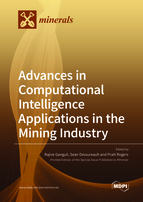Advances in Computational Intelligence Applications in the Mining Industry
A special issue of Minerals (ISSN 2075-163X).
Deadline for manuscript submissions: closed (17 September 2021) | Viewed by 54090
Special Issue Editors
Interests: machine learning; artificial intelligence; mining engineering; systems engineering
Special Issues, Collections and Topics in MDPI journals
Interests: management information systems; mining technology and automation management; real options analysis; data warehousing; data mining; sustainable development indicators
Interests: production or operations management; operations research; machine learning; information or data centers
Special Issues, Collections and Topics in MDPI journals
Special Issue Information
Dear Colleagues,
Computational intelligence (machine learning, deep learning, genetic algorithms, etc.) has really taken off in the mining industry. It is not a new field for mining industry applications. Until now, however, applications were mostly academic where members of academia applied various computational intelligence (CI) techniques to whatever datasets the industry was comfortable sharing with academia. The results of CI never made it back to mine sites as there was no real interest. However, this is starting to change. Some mining companies now have analytics teams that apply CI to operational data. They are developing a deeper understanding of the challenges of CI, such as requiring major data structure and maintaining sensor quality. New tools are also being developed for the mining industry such as those using natural language processing. Therefore, in this issue, we would like to compile the state of the art in real-world mining industry applications of CI. What is being applied at mine sites? What real-world tools are being developed for mining industry applications? What is working? Why do you think it is working? What is not working? What are the challenges?
Papers can be on any aspect of the mining industry. They must, however, be about the computational intelligence applications. They must describe the application, benefits being seen, and/or the challenges to their deployment or development. Papers should not look like advertisements for commercial products. They should have sufficient technical information to satisfy reviewers, as well as readers.
Prof. Dr. Rajive Ganguli
Dr. Sean Dessureault
Dr. Pratt Rogers
Guest Editors
Manuscript Submission Information
Manuscripts should be submitted online at www.mdpi.com by registering and logging in to this website. Once you are registered, click here to go to the submission form. Manuscripts can be submitted until the deadline. All submissions that pass pre-check are peer-reviewed. Accepted papers will be published continuously in the journal (as soon as accepted) and will be listed together on the special issue website. Research articles, review articles as well as short communications are invited. For planned papers, a title and short abstract (about 100 words) can be sent to the Editorial Office for announcement on this website.
Submitted manuscripts should not have been published previously, nor be under consideration for publication elsewhere (except conference proceedings papers). All manuscripts are thoroughly refereed through a single-blind peer-review process. A guide for authors and other relevant information for submission of manuscripts is available on the Instructions for Authors page. Minerals is an international peer-reviewed open access monthly journal published by MDPI.
Please visit the Instructions for Authors page before submitting a manuscript. The Article Processing Charge (APC) for publication in this open access journal is 2400 CHF (Swiss Francs). Submitted papers should be well formatted and use good English. Authors may use MDPI's English editing service prior to publication or during author revisions.
Keywords
- machine learning
- deep learning
- mining industry
- artificial intelligence
- evolutionary computing
- mineral processing






